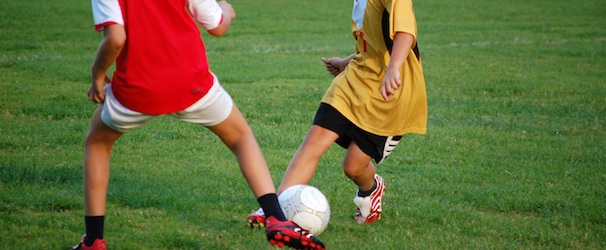 Your child’s success in athletics – regardless of the sport – depends largely on how well his visual system operates. Motor skills rely on signals between the eyes, brain and muscles – in fact, the eyes tell the hands and feet what to do. Therefore, if your child’s sports performance is lacking, he might not need practice as much as a vision examination.
Your child’s success in athletics – regardless of the sport – depends largely on how well his visual system operates. Motor skills rely on signals between the eyes, brain and muscles – in fact, the eyes tell the hands and feet what to do. Therefore, if your child’s sports performance is lacking, he might not need practice as much as a vision examination.
Having 20/20 vision does not mean a child has good visual skills for sports competition. It simply means they can stand still and see an object 20 feet away relatively clear. It does not help them see where a ball is in space, how fast it is traveling, or whether or not it is changing direction. It won’t help them hit a pitch, catch a pass, or move their feet to the right place.
Parents who insist that a child simply isn’t good at sports may be ignoring a potential vision problem. A child’s sports performance is a good indicator of his vision health. If he struggles in athletics, it is likely he has a vision problem that will make other areas of his life difficult as well. A behavioral optometrist can assess all areas of vision, whereas a basic exam does not. Some problems are easily remedied, while others are potentially dangerous or complicated situations that require in-depth treatment.
Vision problems that can influence sports performance include focusing troubles, convergence deficiencies, lazy eye, misaligned eyes, suppressed vision, poor eye teamwork, vision field loss including side vision or depth perception, near- and far-sightedness, as well as a number of other issues.
There are warning signs parents can look for that may suggest vision problems, such as:
- Inconsistent performances, effort without results
- Awkward movement, poor coordination and balance
- Poor timing of motor actions
- Inaccurate throws, catches, swings
- Striking out frequently, swinging too late or too early
- Running for a football, soccer or tennis ball but not connecting
- Poor basketball shooting, often not even hitting rim
- Regularly missing the net in hockey or soccer
- Fouls or collisions because of bad timing or poor depth perception
- Trouble riding or balancing a bicycle or skateboard
- Poor coordination in gymnastics
It is often believed that the vision you are born with is the vision you have to live with. This is false. Vision is a learned skill, which means it can be taught, enhanced and improved – for sports competition as well as education and learning. As a behavioral optometrist certified in sports vision therapy, I can evaluate, diagnose and provide training to improve your child’s visual skills for better sports performance.
Following evaluation and diagnosis, we have many options to offer. There are glasses which enhance sports vision, as well as colored light therapy and vision therapy which can improve vision. Our therapy programs have drills which focus on hand-eye coordination, balance and concentration, while training the brain, eyes and muscles to work together in tandem for optimal sports performance.
Due to increased awareness of the benefits of vision therapy, many professional athletic teams are hiring vision therapists to work with their athletes, to evaluate vision and set up training regimens to enhance it. These vision training programs are just as important as weightlifting, diet, and daily practice. Effort and attitude are commendable, but without good vision skills, it is impossible for a child or adult to reach his athletic potential.
There are many facets of vision necessary for playing sports. While some sports require more proficiency in certain areas, here are some general visual skills we can improve with vision therapy:
- Hand-Eye-Body Coordination – Timing and control depend on how well your hands, feet, body and other muscles respond to information from the eyes
- Eye Tracking – Literally “keep your eye on the ball,” wherever it is on the field/court
- Focus Flexibility – Changing focus from far to near
- Visual Reaction Time – The speed at which your brain interprets an opponent’s action or ball movement and reacts to it
- Depth Perception – Judges the speed and distance between yourself and the ball or another person or boundary
- Peripheral Awareness – Seeing a person or object out of the corner of your eye
- Visualization – Picturing making the catch or hitting the ball can trick the brain into thinking it is real
- Visual Memory – Fast decision-making based on visually remembering formations, patterns and strategies practiced
- Visual Concentration – Avoid distraction by movement from people or objects not in the game
- Balance – The eyes must send proper information to the brain to create steady, fluid movement
- Dynamic Visual Acuity – Seeing moving objects clearly, such as a fast pitch or a tennis serve
- Fusion Flexibility and Stamina – Keep both eyes working together even under high speed and stress
Contact us if you are interested in improving your sports vision skills or are concerned about a vision problem; we work with children, teenagers and adults. Particularly, if your child is the one everyone roots for because he just can’t hit a baseball or catch a ball, please call us. Not only will we cheer for him along with you – but we can go a step further. We have the tools to change his life. Please give us the opportunity. Call today for more information or to schedule a vision evaluation.